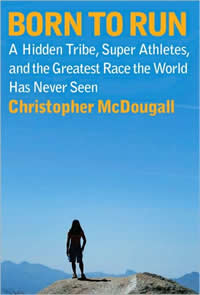Book Notes
 Christopher McDougall, Born to Run; A Hidden Tribe, Superathletes, and the Greatest Race the World Has Never Seen (New York: Knopf, 2009), 282pp.
Christopher McDougall, Born to Run; A Hidden Tribe, Superathletes, and the Greatest Race the World Has Never Seen (New York: Knopf, 2009), 282pp.
A while back I saw a buff, college-age guy running through town in his bare feet. At first I thought he was crazy, but after reading this book I now think he's part of the "barefoot running" craze described by Christopher McDougall in his new best seller. For most people, "barefoot" does not mean no more expensive shoes. Devotees shell out over $100 for a pair of minimalist kickers that simulate bare feet but offer protection, like the Vibram FiveFingers or Nike Free. At our local running store there's a three week wait for such foot gloves.
McDougall traveled to the remote and reclusive Tarahumara Indians ("a near-mythical tribe of Stone Age superathletes") in the Copper Canyons of Mexico. They run for hundreds of miles with almost nothing on their feet, eat a simple diet, and according to McDougall enjoy extraordinarily good mental, spiritual, and physical health. In fact, the Tarahumara, who have no written language or monetary system, were badly exploited by marketers like Rick Fisher when they participated in the 1992 and 1994 Leadville 100 mile trail runs. In 1992, the 52 year-old Tarahumara named Victoriano Churro bested the field. When they figured out how they were being used and abused, after 1994 they retreated to their isolated enclaves and never returned to Leadville. In the end, McDougall, and an equally elusive and mysterious Caballo Blanco, took "the greatest race the world has never seen" to the Copper Canyons, where a handful of oddball-elite runners joined the Tarahumara on their own turf and raced 50 miles for the pure joy of it.
In addition to his attractive if amateur anthropology, McDougall tracks down sports medicine experts, elite trainers, world class runners, and scientific studies to explain how and why running barefoot is better than running in expensive shoes that marketers have convinced us that we need. It has to do with our evolution and "persistence hunting" by running. He caught my attention, to give just one example, when he recounts his time with the Stanford track coach Vin Lananna. The Nike reps were at Stanford when they noticed the Stanford runners training in their bare feet. When the Nike reps asked why, Lananna responded, "I can't prove this, but I believe that when my runners train barefoot, they run faster and suffer fewer injuries." I'm not sure that running shoes are "the worst crime ever committed against the human foot" (138) or "the most destructive force to ever hit the human foot" (168), but as a former marathoner I enjoyed this book. It all sounds crazy, and I'm not giving up shoes, but "one thing about crazy people — they see things that other people don't" (256).


